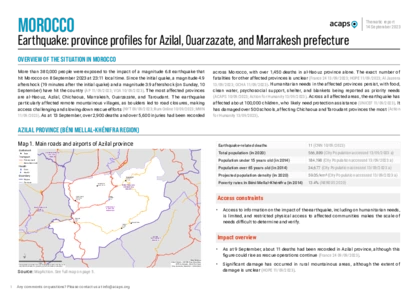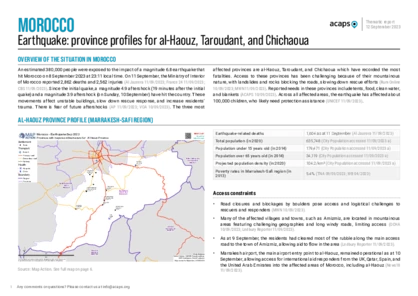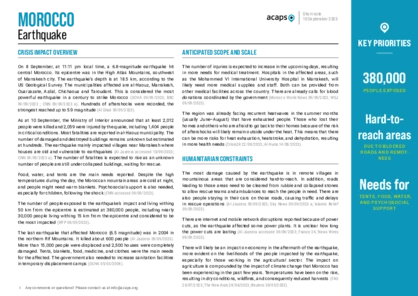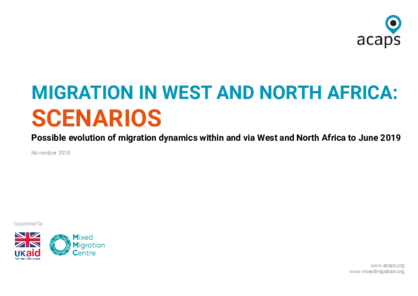Latest updates on country situation
06 March 2025
Among the humanitarian response programmes that the US funding freeze has affected globally are those in Morocco, including programmes related to the HIV/AIDS response, Al Haouz earthquake recovery efforts, migrant protection programmes, and educational initiatives. By January 2025, Morocco was hosting more than 26,500 refugees and asylum seekers and an unknown number of migrants, who continue to have high protection concerns given exposure to exploitation by human traffickers and arbitrary detention by security forces. The funding freeze has affected programmes to combat human trafficking, strengthen victim protection mechanisms, establish shelters, train government responders, and provide healthcare services, including HIV prevention and treatment for migrants. Recovery programmes following the Al Haouz earthquake in September 2023 are also at risk of suspension. These include programmes for promoting economic integration for women and youth. The earthquake affected over 2.8 million people and displaced 500,000. (MWN 25/02/2025, Hespress 27/02/2025, USAID 16/01/2025)
18 September 2024
At least 200 migrants, refugees, and asylum seekers attempted to cross the border fence from Findeq town, Morocco, into the Spanish enclave Ceuta on 15 September 2024. This came after a social media campaign calling for a mass migration attempt. The majority of the people who tried to cross the border were Moroccan youth, driven by poverty and lack of employment opportunities in the country. About 30 people also attempted to swim around the border fence, resulting in one fatality. Moroccan security forces stopped those trying to cross and arrested 60 people believed to have incited the mass migration. Between January–September, the Moroccan authorities stopped around 45,000 migration attempts, with 1,917 migrants arriving at Ceuta between January–August. This represents a nearly 195% increase from the same period in 2023. The centres receiving migrants in Spain are already overcrowded at 420% of their capacity. (IM 16/09/2024, The North Africa Post 15/09/2024, MWN 11/09/2024)
29 October 2023
People displaced by the earthquake that hit Morocco on 8 September 2023 continue to reside in tents and have shelter needs. The start of the rainy season has made conditions worse. On 21 October, a storm with strong winds affected the country, destroying people’s tents. On 24 October, demonstrations involving hundreds of people in Amizmi town called upon the Government to provide housing. (BBC 25/10/2023, The New Arab 23/10/2023)
11 September 2023
An estimated 380,000 people are exposed to the impact of a magnitude 6.8 earthquake that hit central Morocco on 8 September 2023. The quake killed at least 2,000 people and injured 2,000 others. The numbers of displaced people and damaged or destroyed buildings remain unknown. The most affected areas include some hard-to-reach villages in al-Haouz and Taroudant. Those in need require food, clean water, tents, and blankets. (ACAPS 10/09/2023, IFRC 11/09/2023)
05 July 2023
Between 15 June and 1 July 2023, at least 90 migrants, refugees, and asylum seekers died while attempting to cross from Morocco to Canary Islands, Spain. As the weather improved in June, the migration movement over the Western Mediterranean route increased. About 2,600 migrants arrived in Spain that month alone, while 4,400 arrivals were recorded between January–May 2023. The majority of migrants are from Ethiopia, Gambia, Senegal, Sri Lanka, and Sudan, and they seek migration to escape insecurity and worsening economic conditions in their countries. The use of wooden or inflatable boats and overcrowding are some of the factors leading to more accidents in the Mediterranean. On 21 June, a lack of coordination between rescue teams in Spain and Morocco contributed to the delayed rescue of a boat that eventually capsized, killing at least 37 people. Generally, new arrivals to Spain need medical attention and registration assistance. (InfoMigrants 03/07/2023, BBC 23/06/2023, UNHCR 28/06/2023)
current crises
in
Morocco
These crises have been identified through the INFORM Severity Index, a tool for measuring and comparing the severity of humanitarian crises globally.
MAR002 - International displacement
Last updated 20/11/2025
Drivers
International Displacement
Crisis level
Country
Severity level
1.5 Low
Access constraints
2.0
Analysis products
on
Morocco
14 September 2023
Morocco: earthquake province profiles for Azilal, Ouarzazate, and Marrakesh prefecture
DOCUMENT / PDF / 2 MB
Since the initial quake, a magnitude 4.9 aftershock (19 minutes after the initial quake) and a magnitude 3.9 aftershock (on Sunday, 10 September) have hit the country. The most affected provinces are al-Haouz, Azilal, Chichaoua, Marrakesh, Ouarzazate, and Taroudant. The earthquake particularly affected remote mountainous villages, as boulders led to road closures, making access challenging and slowing down rescue efforts.
12 September 2023
Earthquake in Morocco: province profiles for al-Haouz, Taroudant, and Chichaoua
DOCUMENT / PDF / 2 MB
An estimated 380,000 people were exposed to the impact of a magnitude 6.8 earthquake that hit Morocco on 8 September 2023. The three most affected provinces are al-Haouz, Taroudant, and Chichaoua which have recorded the most fatalities. Access to these provinces has been challenging because of their mountainous nature slowing down rescue efforts.
10 September 2023
Morocco: earthquake
DOCUMENT / PDF / 273 KB
On 8 September, a 6.8-magnitude earthquake hit central Morocco. Its epicentre was in the High Atlas Mountains, southwest of Marrakesh city. The number of damaged and destroyed buildings remains unknown but estimated at hundreds. Food, water, and tents are the main needs reported.
19 December 2018
Morocco: Migrants in Ouled Ziane, Casablanca
DOCUMENT / PDF / 248 KB
Moroccan authorities have dismantled shelters and arrested over 6,500 migrants between July and September 2018, forcing thousands of migrants to increasingly move to cities, and away from makeshift shelters in forests near Tangier and Nador, where they waited to cross the Mediterranean sea to reach Europe.
30 November 2018
Migration in West and North Africa
DOCUMENT / PDF / 855 KB
These scenarios consider how migration dynamics within and via West and North Africa (including across the Mediterranean Sea) might evolve in the first half of 2019 and the potential humanitarian consequences. The aim is to support strategic planning, create awareness and promote preparedness activities for policymakers and other actors working on migration.






